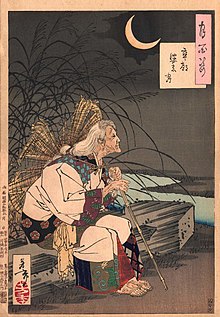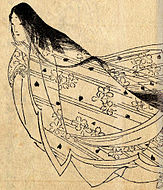| |
小野小町(约809年—约901年)是日本平安时代早期著名的女和歌歌人,是“六歌仙”和《古今和歌集》收录作者中的唯一女性,著有《小町集》。
生平及传说
小野小町是出羽郡司小野良真的女儿,传说出生于现在的秋田县汤泽市小野(以前的雄胜郡雄胜町小野)。其生平不详,民间有传说指她曾是仁明天皇的后宫更衣。相传容貌美艳绝伦,使小町成为后世美女的代称。
在著名的“百夜通”传说中,深草少将深深爱慕着小町。小町告诉他:如能风雨无阻地连续拜访她一百个夜晚,她就答应作他的情人。少将连续拜访99夜,最后一夜遭遇风雪,在路上冻死(一说因风雪未能完成许愿,伤心而死)。小町听到死讯,大为悲伤。另外,小町年迈后怀念昔年的美貌、荣华和众多追求者也是一个日本文学中著名的意象。这些成为后世文学作品的题材。特别是能剧中有《卒都婆小町》、《关寺小町》等,合称“七小町”。
传说中,小町晚年居于京都随心院,今存小町歌碑、妆井、文冢等。另外日本秋田新干线列车的昵称“小町”,也是为了纪念她。
作品
其和歌的题材多男女之爱,特别是暗恋和咏梦。风格鲜丽哀婉。
其最著名的一首(出自《小仓百人一首》):
| “ | 花の色は うつりにけりな いたづらに わが身世にふる ながめせしまに | ” |
相关条目
- ^ 按‘大日本史’考证:世有玉造小町壮衰书,未知何人著。或曰僧空海,或曰三善清行。载小町年老,乞食道路。世以为小野小町。十训抄、着闻集皆载其事,以玉造小町、小野小町为一人。长明无名钞亦引在原业平所闻骷髅歌为一人。徒然草以空海、小町年代相隔,疑为非其所著。今案,小野、玉造,各自一姓,故不取。
Ono no Komachi (小野 小町, c. 825 – c. 900[citation needed]) was a Japanese waka poet, one of the Rokkasen — the six best waka poets of the early Heian period. She was renowned for her unusual beauty, and Komachi is today a synonym for feminine beauty in Japan. She also counts among the Thirty-six Poetry Immortals.
Life
Almost nothing of Komachi's life is known for certain, save for the names of various men with whom she engaged in romantic affairs and whose poetry exchanges with her are preserved in the Kokin Wakashū. She was probably born between 820 and 830, and she was most active in composing poetry around the middle of the ninth century.
Extensive study has gone into trying to ascertain her place of birth, her family and so on, but without conclusive results. The Edo-period scholar Arai Hakuseki advanced the theory that there was more than one woman named Komachi and that the legends about her referred to different people. This theory was later expanded to conjecture that there were four "Komachis". It has been conjectured that she was a lady-of-the-bedchamber (更衣, kōi) in the service of Emperor Ninmyō, and when the latter died in 850 she started relationships with other men.
According to one tradition, she was born in what is now Akita Prefecture, daughter of Yoshisada, Lord of Dewa. The Noh play Sotoba Komachi by Kan'ami describes her as "the daughter of Ono no Yoshizane, the governor of Dewa". Her social status is also uncertain. She may have been a low-ranking consort or a lady-in-waiting of an emperor.
The headnote to poem #938 in the Kokinshū implies she had some sort of connection to Fun'ya no Yasuhide.
Legends
Legends about Komachi (小町伝説/小町説話, Komachi-densetsu/Komachi-setsuwa) had developed as early as the eleventh century. They were later used extensively by the writers of Noh plays.
Stories abound of Komachi in love. One of the legends about her is that she was a lover of Ariwara no Narihira, her contemporary poet and also a member of the Rokkasen. It has been speculated that this legend may derive from the perhaps-accidental placement of one her poems next to one of Narihira's.
Another group of legends concern her cruel treatment of her lovers, notably Fukakusa no Shōshō, a high-ranking courtier. Komachi promised that if he visited her continuously for a hundred nights, then she would become his lover. He visited her every night, regardless of the weather, but died on the ninety-ninth night.
A third type of legend tells of an aged Komachi, forced to wander in ragged clothes, her beauty faded and her appearance so wretched that she is mocked by all around her, as punishment for her earlier mistreatment of her lovers. Yet another group of legends concern her death, her skull lying in a field; when the wind blows through the skull’s eye socket the sound evokes Komachi's anguish.
A different categorization system for Komachi legends was given by Masako Nakano. She gives five groupings:
- "tales of beauty" (美人説話, bijin-setsuwa)
- "tales of sensuality" (好色説話, kōshoku-setsuwa)
- "tales of haughtiness" (驕慢説話, kyōman-setsuwa)
- "tales of poetry/poetic virtue" (歌人・歌徳説話, kajin/katoku-setsuwa)
- "tales of downfall/bemoaning old age" (零落・衰老説話, reiraku/suirō-setsuwa)
Poetry
Almost all of Komachi's extant poems are melancholic. Poet and translator Kenneth Rexroth and Ikuko Atsumi said of her poetry:
Most of her waka are about anxiety, solitude or passionate love.[citation needed] In the Kokinshū, all but one of her poems—the one that later appeared in the Hyakunin Isshu, quoted below—were classified as either "love" or "miscellaneous" poems. She is the only female poet referred to in the kana preface (仮名序, kana-jo) of the anthology[citation needed], which describes her style as "containing naivety in old style but also delicacy".[citation needed]
One of her poems was included as #9 in Fujiwara no Teika's Ogura Hyakunin Isshu:
The poem was originally included in the Kokinshū as #133, in the section dedicated to seasonal (spring[citation needed]) poetry. The poem is filled with many layers of significance, with almost every word carrying more than one meaning. It was the subject of a short essay appended to Peter McMillan's translation of the Ogura Hyakunin Isshu.
In his Seeds in the Heart, translator, critic and literary historian Donald Keene said that "[t]he intensity of emotion expressed in [her] poetry not only was without precedent but would rarely be encountered in later years. […] Komachi's poetry, however extravagant in expression, always seems sincere." He also praised her poetry along with that of the other poets of the “dark age” of waka in the ninth century in the following terms:
Legacy
The many legends about her have made her the best-known of the Rokkasen in modern times. Until relatively recently, when the title "Miss XYZ" became common in Japan, the woman considered most beautiful in such-and-such town or region would be dubbed "XYZ Komachi". She and her contemporary Ariwara no Narihira are considered archetypes of female and male beauty, respectively, and both feature heavily in later literary works, particularly Noh plays.
Komachi features frequently in later-period literature, including five Noh plays: Sotoba Komachi, Sekidera Komachi, Ōmu Komachi, Sōshi Arai Komachi and Kayoi Komachi. These works tend to focus on her talent for waka and her love affairs and the vanity of a life spent indulging in romantic liaisons. Komachi's old age is also frequently portrayed: when she has lost her beauty, has been abandoned by her former lovers, and now regrets her life, wandering around as a lonely beggar woman — albeit still appreciated by young admirers of her poetry. This fictional description is influenced by Buddhist thought and there may be no factual resemblance between it and the historical reality.
Mishima Yukio reworked Sotoba Komachi for the modern theater, publishing his version in January 1952. It was first performed the following month. The basic plot (the age-worn former beauty encounters a young poet and relates some of her life's story, which causes him to fall in love with her, with fatal results) is retained, but the action takes place in a public park, with flashbacks to the salons and ballrooms of Meiji-era Japan.[citation needed] An English translation by Donald Keene was published in 1967.[citation needed]
The play Three Poets by playwright Romulus Linney includes a one act story about Komachi the poet.
In her honor, the Akita Shinkansen is named Komachi. A variety of rice, Akita Komachi, also bears her name.
Gallery
- Ono no Komachi image gallery
References
- ^ Digital Daijisen entry "komachi". Shogakukan.
- ^ a b c d Keene 1999 : 233.
- ^ Keene 1999 : 233, citing Katagiri 1975 : 59-60.
- ^ Keene 1999 : 233, citing Katagiri 1975 : 23-24.
- ^ a b c Rexroth and Atsumi 1977 : 141.
- ^ Keene 1999 : 1011.
- ^ a b Keene 1999 : 235.
- ^ Keene 1999 : 234, citing Katagiri 1975 : 66.
- ^ a b c d e f g Keene 1999 : 234.
- ^ a b Keene 1999 : 233-234, citing Katagiri 1975 : 12, 155.
- ^ Nakano 2004 : 14.
- ^ Suzuki et al. 2009 : 18-19.
- ^ McMillan 2010 : 157.
- ^ McMillan 2010 : 11.
- ^ Keene 1999 : 234, and accompanying note (p. 242, note 66).
- ^ McMillan 2010 : 105.
- ^ McMillan 2010 : 105-110.
- ^ Keene 1999 : 237.
- ^ Keene 1999 : 224.
- ^ Katagiri 2015 : 8.
- ^ Keene 1999 : 225.
- ^ Keene 1970 : 67.
- ^ a b Arimoto 1985, p. 49.
- ^ Gussow, Mel (23 November 1989). "Review/Theater; Women Who Wrote Verse and Suffered". New York Times. Retrieved 27 November 2011.
- ^ a b "Ono no Komachi" Archived 2015-04-02 at the Wayback Machine on the "Team Furusato" website Archived 2015-04-05 at the Wayback Machine. Akita Accounting College of Accounting & Information.
Cited works
- Arimoto, Nobuko (25 December 1985). "Mishima Yukio "Sotoba Komachi" Ron: Shigeki no Kokoromi". Kindai Bungaku Shiron (in Japanese). Hiroshima University (Hiroshima Daigaku Kindai Bungaku Kenkyūkai). 23 (1): 49–60. Retrieved 2017-10-12.
- Hirshfield, Jane; Aratani, Mariko (1990). The Ink Dark Moon: Love Poems by Ono no Komachi and Izumi Shikibu, Women of the Ancient Court of Japan. New York: Vintage Books. ISBN 0-679-72958-5.
- Katagiri, Yōichi 1975. Ono no Komachi Tsuiseki. Tokyo: Kasama Shoin.
- Katagiri, Yōichi (2015). Shinsō-ban: Ono no Komachi Tsuiseki. Tokyo: Kasama Shoin. ISBN 978-4-305-70781-9.
- Katagiri Yōichi 2009 (2nd ed.; 1st ed. 2005). Kokin Wakashū. Tokyo: Kasama Shoin.
- Keene, Donald (1970). Twenty Plays of the Nō Theater. New York: Columbia University Press. ISBN 0-231-03454-7.
- Keene, Donald (1999). A History of Japanese Literature, Vol. 1: Seeds in the Heart — Japanese Literature from Earliest Times to the Late Sixteenth Century. New York: Columbia University Press. ISBN 978-0-231-11441-7.
- McMillan, Peter 2010 (1st ed. 2008). One Hundred Poets, One Poem Each. New York: Columbia University Press.
- Nakano, Masako (2004), "Ono no Komachi", in Tanaka, Noboru; Yamamoto, Tokurō (eds.), Heian Bungaku Kenkyū Handobukku (in Japanese), Tokyo: Izumi Shoin, pp. 14–15, ISBN 978-4-7576-0260-1
- Rexroth, Kenneth; Atsumi, Ikuko (1977). Woman poets of Japan. New York: New Directions Pub. Corp. ISBN 0-8112-0820-6.
- Suzuki Hideo, Yamaguchi Shin'ichi, Yoda Yasushi 2009 (1st ed. 1997). Genshoku: Ogura Hyakunin Isshu. Tokyo: Bun'eidō.





